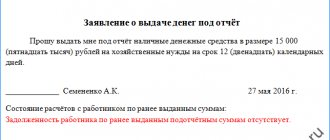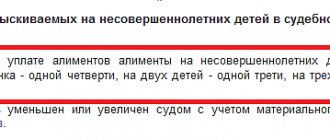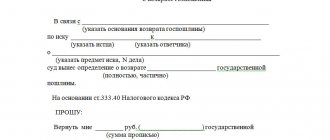Possibility of setting up the program and the procedure for making calculations
To start working with the executive document, go to the “Settings-Payroll” menu. Next, you need to click on the active hyperlink “Setting up the composition of charges and deductions”.
In the “Salary Deductions” tab, check the box to register the start of deductions from the employee’s salary in the “Deductions by executive documents” item.
After activating this program function, a “Deductions” section will be created in the “Salary” menu. Two subsections will become active in the section - “Alimony and other deductions” and “Writs of execution”.
Setting up the program often causes difficulties, so contact our specialists for help.
“Instructions on enforcement proceedings” (approved by Order of the USSR Ministry of Justice dated November 15, 1985 no. 22)
Approved by order of the Ministry of Justice of the USSR of November 15, 1985 N 22 INSTRUCTIONS ON EXECUTIVE PROCEEDINGS Enforcement proceedings in the courts are conducted in the manner established by the Fundamentals of Civil Proceedings of the USSR and Union Republics, civil procedural codes of the Union Republics and in accordance with the rules set forth in this Instruction. Chapter I BASIC PROVISIONS General conditions for the actions of the bailiff 1. According to the rules set out in these Instructions, the following are subject to execution: 1) decisions, rulings, and decisions of courts in civil cases (with the exception of decisions in cases of collecting arrears from citizens on state and local taxes and fees, compulsory salary insurance and self-taxation); ——————————— Execution of decisions of judicial authorities on the collection of arrears from citizens on state and local taxes and fees, compulsory salary insurance and self-taxation is carried out by the relevant collection authority according to the rules established by the legislation of the USSR. 2) sentences, rulings and decisions of courts in criminal cases regarding property penalties; 3) a decision of a judge or court regarding property penalties for committing administrative offenses; 4) settlement agreements approved by the court; 5) decisions of the prosecutor on the administrative eviction of persons who arbitrarily occupied residential premises or living in houses threatening to collapse; 6) executive inscriptions of notarial authorities; 7) decisions of arbitration bodies in cases provided for by law; decisions of the Maritime and Foreign Trade Arbitration Commissions under the USSR Chamber of Commerce and Industry and arbitrations specially formed to consider individual cases; 9) payment requests accepted by the payer that were not paid on time; 10) decisions of comrades' courts on property penalties; 11) decisions of arbitration courts; 12) decisions of commissions on labor disputes; 13) resolutions of trade union committees on labor disputes and disputes on compensation for damage caused by injury or other damage to health, as well as the death of the breadwinner; 14) decisions made by bodies (officials) authorized to consider cases of administrative offenses in cases established by law; 15) decisions of the executive committees of district and city Councils of People's Deputies on the forced sale of a second home owned by a citizen as personal property; 16) decisions of the executive committees of rural, town and city Councils of People's Deputies on the recovery of damages from state institutions, enterprises, collective farms and other cooperative and public organizations for crop damage and damage to plantings; 17) decisions of foreign courts in cases provided for by law. 2. Execution of those listed in Art. 1 acts are carried out by bailiffs attached to district (city) people's courts. Bailiffs are appointed and dismissed by the heads of departments of justice of the executive committees of regional, regional, city Councils of People's Deputies, ministers of justice of autonomous republics, and in union republics without regional divisions - by ministers of justice of union republics. In courts where there are two or more bailiffs, one of them is appointed as a senior bailiff. 3. Management of the activities of bailiffs is entrusted to the chairmen of district (city) people's courts and people's judges. These officials are obliged to exercise daily control over the correct and timely execution of court decisions, over compliance by bailiffs with the established rules of execution and provide them with the necessary assistance. The chairmen of district (city) courts and people's judges check the work of each bailiff quarterly, drawing up an inspection report, especially paying attention to the efficiency in taking measures to enforce court decisions, the validity of the return of enforcement documents to collectors, the regularity and quality of enforcement checks in organizations, institutions, and enterprises , as well as the financial activities of bailiffs. 4. Representatives of public organizations and labor collectives who are not parties to the case may be allowed by a judge or bailiff to participate in the execution of decisions if this is caused by state or public interests and can contribute to faster and more correct execution of the court decision. Representatives of the public are allowed to participate in the execution of decisions if they have the appropriate powers - extracts from the decision of the general meeting of the team, from the decision of the governing body of the public organization, etc. Representatives of the public have the right to familiarize themselves with the materials of enforcement proceedings and to be present when the bailiff carries out enforcement actions. Representatives of the public carry out their activities under the control of a bailiff. They are not authorized to take enforcement measures on their own. 5. A bailiff cannot participate in enforcement in the following cases: 1) if he is a relative of the parties, other persons participating in the case, or a relative of representatives; 2) if he is personally directly or indirectly interested in the outcome of the case or there are other circumstances that raise doubts about his impartiality. The bailiff is obliged to inform the judge about the existence of these circumstances. On the same grounds, a challenge to a bailiff can be filed by the claimant, debtor or their representative, as well as by the prosecutor. The issue of challenging a bailiff is resolved by the judge or the people's court of which he is a member, in the manner established by the relevant articles of the Code of Civil Procedure of the Union Republics. 6. In case of challenge of a bailiff, the executive document, as determined by a people’s judge, is transferred to another bailiff of the same court, and if there is only one bailiff attached to the court, it is sent through the department of justice of the executive committee of the city, regional, regional Council of People’s Deputies, the Ministry of Justice of the autonomous republic, to in union republics without regional division - the Ministry of Justice of the union republic for execution in another people's court. 7. A ruling to refuse to challenge a judicial execution can be appealed and protested in the prescribed manner to a higher court, however, filing a complaint or protest does not suspend the execution of enforcement actions. All documents related to the issue of challenging a bailiff are attached to the relevant enforcement proceedings. 8. The execution of the decision is carried out by the bailiff at the place of residence, or at the place of work of the debtor, or at the location of his property within the city or district served by the district (city) people's court to which the bailiff is a member. If the debtor is a legal entity, then execution is carried out at the location of its body or property. If necessary, the bailiff continues enforcement actions outside the served area within the limits established by the civil procedural codes of the Union republics according to a special instruction or determination of the judge in each individual case. 9. If, during the execution process, the debtor has moved to the area of another court and there is no property left at the debtor’s previous place of residence, the bailiff draws up an act about this and sends the writ of execution in the prescribed manner to the court at the new place of residence of the debtor, what the claimant is notified about. At the direction of the head of the department of justice of the corresponding executive committee of the regional, regional, city Council of People's Deputies, the Minister of Justice of the autonomous republic, and in union republics without regional division, at the direction of the Minister of Justice of the union republic, the bailiff carries out enforcement actions within the region, territory, republic. 10. On non-working days, execution of a decision is allowed in urgent cases and with the permission of the judge of the court where the bailiff is a member. At night, execution can take place only in those union republics whose Civil Procedure Code provides for such a possibility, and in all cases, written permission from a people’s judge is required to carry out enforcement actions at night. The duration of night time is determined by the relevant articles of the Civil Procedure Code of the Union Republics. 11. The expenses necessary for the execution of the decision for the storage and transportation of the debtor’s property, for the publication of the sale of a residential building at auction, for the payment of experts, for the travel of the bailiff to the place of execution are made according to the estimate of the court to which the bailiff is a member. These expenses are recovered from the debtor by the court, regardless of the recovery of property or sums of money from him under the executed decision. A private complaint or protest may be filed against this determination. 12. Delivery and forwarding to the claimant by mail of amounts collected in compensation for damage caused to workers and employees by injury or other damage to health, as well as the death of the breadwinner, is carried out at the expense of the debtor. In all other cases, transfer by mail of amounts collected under executive documents is made at the expense of the claimant. 13. In accordance with Art. 17 Fundamentals of the legislation of the USSR and union republics on the judicial system in the USSR and Art. 55 of the Fundamentals of Civil Proceedings of the USSR and Union Republics, the requirements of the bailiff for the execution of court decisions are mandatory for all state enterprises, institutions, organizations, collective farms, other cooperative organizations, their associations, other public organizations, officials and citizens throughout the USSR. 14. The bailiff begins enforcement actions upon an oral or written application from the claimant or his representative, upon the application of the prosecutor and upon the proposal of the judge, as well as upon the application of government bodies, trade unions, state enterprises, institutions, collective farms, other cooperative organizations, their associations, other public organizations or individual citizens in cases where a civil case was initiated on their initiative in the interests of other persons. If a citizen is recognized as having limited legal capacity, the court sends a copy of the decision to the guardianship and trusteeship authorities. A copy of the decision is given to the bailiff to monitor the execution of the decision regarding the appointment of a trustee. The bailiff reports to the judge about the appointment of a trustee, and the file with the appropriate note is submitted to the archives. 15. The bailiff is obliged, on his own initiative, to take all legal measures for the prompt and effective execution of the decision, to explain to the parties their rights and obligations and to actively help them in protecting their rights and interests protected by law. 16. When carrying out enforcement actions, the bailiff has the right to enter the premises occupied by the debtor and inspect all its storage facilities (storage rooms, cellars, sheds, closets, drawers, etc.). The opening and inspection of premises and storage facilities are carried out in the presence of witnesses, and also, if provided for by the civil procedural code of the union republic, in the presence of a representative of the housing maintenance organization or the executive committee of the local Council of People's Deputies. The bailiff has the right to take other coercive measures. 17. Compulsory enforcement measures include: 1) foreclosure of the debtor’s property by seizure and sale of property; 2) foreclosure on wages, pensions, scholarships and other types of income of the debtor; 3) foreclosure on sums of money and property of the debtor held by other persons; 4) seizure from the debtor and transfer to the recoverer of certain items specified in the court decision; 5) other measures specified in the court decision in accordance with the law. During the execution, the bailiff has the right to summon debtors to court to familiarize themselves with the enforcement documents, as well as to receive oral or written messages and information from the parties and persons not participating in the execution, if they are necessary for the execution. 18. If the debtor refuses to allow the bailiff into the premises he occupies or the location of his property or to open the storage facility, the bailiff invites a representative of the internal affairs bodies or the local (rural) Council of People's Deputies, as well as witnesses, in whose presence he opens the premises or storage facility and performs their inspection. The bailiff does not have the right to conduct a personal search of the debtor and encroach in any form on his personal freedom and dignity. 19. In case of resistance to the bailiff during the execution of the decision, the bailiff, in the presence of attesting witnesses, draws up a report on this, in order to remove obstacles to the execution of the decision, seeks assistance from the authorities and continues enforcement actions. The act, signed by the bailiff and attesting witnesses, is presented to the judge to resolve the issue of bringing to justice persons who resisted the bailiff. 20. The claimant and the debtor have the right to be present when the bailiff performs actions to execute the decision, get acquainted with the materials of the enforcement proceedings and receive the necessary certificates related to the execution of the decision, enter into settlement agreements, challenge the ownership of property and its valuation, and appeal the actions of the bailiff. The settlement agreement concluded by the claimant and the debtor during the execution process is submitted to the bailiff in writing, who, within three days, transfers it to the people's judge for the court to decide on its approval. 21. A bailiff cannot independently grant a deferment or installment plan for execution or change the method and procedure for executing a court decision. If there are circumstances that make the execution of the decision difficult or impossible (natural disaster, lack of awarded property in kind, illness of the debtor or family members, etc.), the bailiff draws up an act about this, which he submits to the people's judge to raise the issue before the court or authority who issued the writ of execution, on the decision to defer or installment execution or on changing the method and procedure for executing the decision. A private complaint may be filed against a court ruling on the issue of delaying or installment execution, as well as changing the method and procedure for execution.
Chapter I BASIC PROVISIONS General conditions for the actions of the bailiff 1. According to the rules set out in these Instructions, the following are subject to execution: 1) decisions, rulings, and decisions of courts in civil cases (with the exception of decisions in cases of collecting arrears from citizens on state and local taxes and fees, compulsory salary insurance and self-taxation); ——————————— Execution of decisions of judicial authorities on the collection of arrears from citizens on state and local taxes and fees, compulsory salary insurance and self-taxation is carried out by the relevant collection authority according to the rules established by the legislation of the USSR. 2) sentences, rulings and decisions of courts in criminal cases regarding property penalties; 3) a decision of a judge or court regarding property penalties for committing administrative offenses; 4) settlement agreements approved by the court; 5) decisions of the prosecutor on the administrative eviction of persons who arbitrarily occupied residential premises or living in houses threatening to collapse; 6) executive inscriptions of notarial authorities; 7) decisions of arbitration bodies in cases provided for by law; decisions of the Maritime and Foreign Trade Arbitration Commissions under the USSR Chamber of Commerce and Industry and arbitrations specially formed to consider individual cases; 9) payment requests accepted by the payer that were not paid on time; 10) decisions of comrades' courts on property penalties; 11) decisions of arbitration courts; 12) decisions of commissions on labor disputes; 13) resolutions of trade union committees on labor disputes and disputes on compensation for damage caused by injury or other damage to health, as well as the death of the breadwinner; 14) decisions made by bodies (officials) authorized to consider cases of administrative offenses in cases established by law; 15) decisions of the executive committees of district and city Councils of People's Deputies on the forced sale of a second home owned by a citizen as personal property; 16) decisions of the executive committees of rural, town and city Councils of People's Deputies on the recovery of damages from state institutions, enterprises, collective farms and other cooperative and public organizations for crop damage and damage to plantings; 17) decisions of foreign courts in cases provided for by law. 2. Execution of those listed in Art. 1 acts are carried out by bailiffs attached to district (city) people's courts. Bailiffs are appointed and dismissed by the heads of departments of justice of the executive committees of regional, regional, city Councils of People's Deputies, ministers of justice of autonomous republics, and in union republics without regional divisions - by ministers of justice of union republics. In courts where there are two or more bailiffs, one of them is appointed as a senior bailiff. 3. Management of the activities of bailiffs is entrusted to the chairmen of district (city) people's courts and people's judges. These officials are obliged to exercise daily control over the correct and timely execution of court decisions, over compliance by bailiffs with the established rules of execution and provide them with the necessary assistance. The chairmen of district (city) courts and people's judges check the work of each bailiff quarterly, drawing up an inspection report, especially paying attention to the efficiency in taking measures to enforce court decisions, the validity of the return of enforcement documents to collectors, the regularity and quality of enforcement checks in organizations, institutions, and enterprises , as well as the financial activities of bailiffs. 4. Representatives of public organizations and labor collectives who are not parties to the case may be allowed by a judge or bailiff to participate in the execution of decisions if this is caused by state or public interests and can contribute to faster and more correct execution of the court decision. Representatives of the public are allowed to participate in the execution of decisions if they have the appropriate powers - extracts from the decision of the general meeting of the team, from the decision of the governing body of the public organization, etc. Representatives of the public have the right to familiarize themselves with the materials of enforcement proceedings and to be present when the bailiff carries out enforcement actions. Representatives of the public carry out their activities under the control of a bailiff. They are not authorized to take enforcement measures on their own. 5. A bailiff cannot participate in enforcement in the following cases: 1) if he is a relative of the parties, other persons participating in the case, or a relative of representatives; 2) if he is personally directly or indirectly interested in the outcome of the case or there are other circumstances that raise doubts about his impartiality. The bailiff is obliged to inform the judge about the existence of these circumstances. On the same grounds, a challenge to a bailiff can be filed by the claimant, debtor or their representative, as well as by the prosecutor. The issue of challenging a bailiff is resolved by the judge or the people's court of which he is a member, in the manner established by the relevant articles of the Code of Civil Procedure of the Union Republics. 6. In case of challenge of a bailiff, the executive document, as determined by a people’s judge, is transferred to another bailiff of the same court, and if there is only one bailiff attached to the court, it is sent through the department of justice of the executive committee of the city, regional, regional Council of People’s Deputies, the Ministry of Justice of the autonomous republic, to in union republics without regional division - the Ministry of Justice of the union republic for execution in another people's court. 7. A ruling to refuse to challenge a judicial execution can be appealed and protested in the prescribed manner to a higher court, however, filing a complaint or protest does not suspend the execution of enforcement actions. All documents related to the issue of challenging a bailiff are attached to the relevant enforcement proceedings. 8. The execution of the decision is carried out by the bailiff at the place of residence, or at the place of work of the debtor, or at the location of his property within the city or district served by the district (city) people's court to which the bailiff is a member. If the debtor is a legal entity, then execution is carried out at the location of its body or property. If necessary, the bailiff continues enforcement actions outside the served area within the limits established by the civil procedural codes of the Union republics according to a special instruction or determination of the judge in each individual case. 9. If, during the execution process, the debtor has moved to the area of another court and there is no property left at the debtor’s previous place of residence, the bailiff draws up an act about this and sends the writ of execution in the prescribed manner to the court at the new place of residence of the debtor, what the claimant is notified about. At the direction of the head of the department of justice of the corresponding executive committee of the regional, regional, city Council of People's Deputies, the Minister of Justice of the autonomous republic, and in union republics without regional division, at the direction of the Minister of Justice of the union republic, the bailiff carries out enforcement actions within the region, territory, republic. 10. On non-working days, execution of a decision is allowed in urgent cases and with the permission of the judge of the court where the bailiff is a member. At night, execution can take place only in those union republics whose Civil Procedure Code provides for such a possibility, and in all cases, written permission from a people’s judge is required to carry out enforcement actions at night. The duration of night time is determined by the relevant articles of the Civil Procedure Code of the Union Republics. 11. The expenses necessary for the execution of the decision for the storage and transportation of the debtor’s property, for the publication of the sale of a residential building at auction, for the payment of experts, for the travel of the bailiff to the place of execution are made according to the estimate of the court to which the bailiff is a member. These expenses are recovered from the debtor by the court, regardless of the recovery of property or sums of money from him under the executed decision. A private complaint or protest may be filed against this determination. 12. Delivery and forwarding to the claimant by mail of amounts collected in compensation for damage caused to workers and employees by injury or other damage to health, as well as the death of the breadwinner, is carried out at the expense of the debtor. In all other cases, transfer by mail of amounts collected under executive documents is made at the expense of the claimant. 13. In accordance with Art. 17 Fundamentals of the legislation of the USSR and union republics on the judicial system in the USSR and Art. 55 of the Fundamentals of Civil Proceedings of the USSR and Union Republics, the requirements of the bailiff for the execution of court decisions are mandatory for all state enterprises, institutions, organizations, collective farms, other cooperative organizations, their associations, other public organizations, officials and citizens throughout the USSR. 14. The bailiff begins enforcement actions upon an oral or written application from the claimant or his representative, upon the application of the prosecutor and upon the proposal of the judge, as well as upon the application of government bodies, trade unions, state enterprises, institutions, collective farms, other cooperative organizations, their associations, other public organizations or individual citizens in cases where a civil case was initiated on their initiative in the interests of other persons. If a citizen is recognized as having limited legal capacity, the court sends a copy of the decision to the guardianship and trusteeship authorities. A copy of the decision is given to the bailiff to monitor the execution of the decision regarding the appointment of a trustee. The bailiff reports to the judge about the appointment of a trustee, and the file with the appropriate note is submitted to the archives. 15. The bailiff is obliged, on his own initiative, to take all legal measures for the prompt and effective execution of the decision, to explain to the parties their rights and obligations and to actively help them in protecting their rights and interests protected by law. 16. When carrying out enforcement actions, the bailiff has the right to enter the premises occupied by the debtor and inspect all its storage facilities (storage rooms, cellars, sheds, closets, drawers, etc.). The opening and inspection of premises and storage facilities are carried out in the presence of witnesses, and also, if provided for by the civil procedural code of the union republic, in the presence of a representative of the housing maintenance organization or the executive committee of the local Council of People's Deputies. The bailiff has the right to take other coercive measures. 17. Compulsory enforcement measures include: 1) foreclosure of the debtor’s property by seizure and sale of property; 2) foreclosure on wages, pensions, scholarships and other types of income of the debtor; 3) foreclosure on sums of money and property of the debtor held by other persons; 4) seizure from the debtor and transfer to the recoverer of certain items specified in the court decision; 5) other measures specified in the court decision in accordance with the law. During the execution, the bailiff has the right to summon debtors to court to familiarize themselves with the enforcement documents, as well as to receive oral or written messages and information from the parties and persons not participating in the execution, if they are necessary for the execution. 18. If the debtor refuses to allow the bailiff into the premises he occupies or the location of his property or to open the storage facility, the bailiff invites a representative of the internal affairs bodies or the local (rural) Council of People's Deputies, as well as witnesses, in whose presence he opens the premises or storage facility and performs their inspection. The bailiff does not have the right to conduct a personal search of the debtor and encroach in any form on his personal freedom and dignity. 19. In case of resistance to the bailiff during the execution of the decision, the bailiff, in the presence of attesting witnesses, draws up a report on this, in order to remove obstacles to the execution of the decision, seeks assistance from the authorities and continues enforcement actions. The act, signed by the bailiff and attesting witnesses, is presented to the judge to resolve the issue of bringing to justice persons who resisted the bailiff. 20. The claimant and the debtor have the right to be present when the bailiff performs actions to execute the decision, get acquainted with the materials of the enforcement proceedings and receive the necessary certificates related to the execution of the decision, enter into settlement agreements, challenge the ownership of property and its valuation, and appeal the actions of the bailiff. The settlement agreement concluded by the claimant and the debtor during the execution process is submitted to the bailiff in writing, who, within three days, transfers it to the people's judge for the court to decide on its approval. 21. A bailiff cannot independently grant a deferment or installment plan for execution or change the method and procedure for executing a court decision. If there are circumstances that make the execution of the decision difficult or impossible (natural disaster, lack of awarded property in kind, illness of the debtor or family members, etc.), the bailiff draws up an act about this, which he submits to the people's judge to raise the issue before the court or authority who issued the writ of execution, on the decision to defer or installment execution or on changing the method and procedure for executing the decision. A private complaint may be filed against a court ruling on the issue of delaying or installment execution, as well as changing the method and procedure for execution.
How to issue a writ of execution in 1C: ZUP
You can start working with the writ of execution in any journal. From the menu options you need to select “Create”. A menu will open that must be filled out using information from the writ of execution or the alimony agreement.
The following data must be entered into the log:
- FULL NAME. the employee to whom the writ of execution is directed;
- recipient of funds;
- period (it is not necessary to enter the date for which deductions will be made);
- calculation method.
If the transfer of funds will be carried out by postal order, indicate the full address of the recipient.
The calculation method is a fixed amount or a certain percentage of the salary. Payments automatically stop when they reach a certain amount. This feature is activated by the “Stop Holds When Limit Reached” tab.
Please note that you must enter the type and details of the writ of execution. The field for entering information is located at the bottom of the screen. The entered details will be visible in printed documents.
The program provides the ability to use a paying agent for collection. To do this, you need to activate the checkbox, select the agent’s name from the list and indicate the tariff for its services (for example, a bank commission for transferring money).
Having filled in the data correctly, save the document by clicking the “Post and Close” button. Please note that the retention calculation is based on the database, which was configured in the “Settings-Retentions” menu.
The document contains information about the type of accruals to the employee from which the amount of deductions from the writ of execution will be debited. If the company has additional payments, they must be entered into the database using the “Selection” button for calculation.
After entering the data, the program will carry out deductions according to the writ of execution automatically. Information about deductions made within the writ of execution can be checked in the “Deductions” tab.
We are trying to create a payslip for an employee.
As can be seen from the figure, the card reflects the amount of deduction.
Where to get a writ of execution based on a court decision
The collection document is received by the claimant on the day the resolution enters into force. As a rule, after 10 days after the decision was announced, a writ of execution in a civil case is issued, since during this time the victim can still appeal the decision in court by filing an appeal. In practice, sometimes you have to wait longer before picking up a certified document. The IL is issued in a single copy, but if a decision is made in favor of more than one claimant, then the number of documents is directly proportional to their number.
- Facial gymnastics for wrinkles
- How to lose weight in a week at home. Diets and exercises for quick weight loss
- How to play checkers
How to close an executive document in 1C
The writ of execution may contain the expiration date of its validity or the amount, the withholding of which ends the validity of the writ of execution. The installed function in the program automatically stops deductions from the employee’s salary.
If the program did not set the date of termination of the writ of execution or the terms of its validity have changed, the sheet can be closed or changed manually. In the journal “Alimony and other permanent deductions”, changes are made to the paragraph “Changes in conditions...”.
In the field you need to select the company employee whose file you want to make changes to. Select the original sheet, move to the “Stop with:” item, and change the date.
Another method to change the terms of payments is to activate the item “Changes of the writ of execution” on the basis (indicate the document).
The fields of the document are filled in automatically; the data is transferred from the specified document. It is only necessary to correct the information on the writ of execution.
This document will be located in the journal “Alimony and other permanent deductions.”
What is a writ of execution
A writ of execution is an official document that is the basis for initiating enforcement proceedings. For a better understanding, you should indicate the main features of this document:
- It is issued only by judicial authorities based on the results of a civil case. The sheet is valid when presented to the bailiffs along with the court decision;
- The specified document contains an indication of the actions that must be performed in favor of the submitter. For example, a court decision satisfied a claim to recover from a debtor a debt amount of 100,000 rubles. Accordingly, after such a decision enters into legal force, the court issues a writ of execution. It reflects the plaintiff’s right to receive 100,000 rubles from the defendant;
- Bailiffs are not empowered to go beyond the sheet. Its provisions must be fulfilled in strict accordance;
- Only the plaintiff has the right to present the sheet for execution. The document itself indicates the details of the person who can present the writ of execution. In this case, it is possible to implement its provisions on the basis of a power of attorney. But such a power of attorney must be exclusively notarized. This allows another person to act as a representative of the plaintiff and present the sheet to the bailiffs;
- Enforcement of a court decision is possible not only through bailiff services. This can also be done directly. For example, the plaintiff receives a court decision to recover a certain amount from the insurance company. Having received a writ of execution, a person has the right to submit it directly to the bank that services the company. You can find out in which bank the company’s account is opened on its official website. Accordingly, the plaintiff avoids bureaucratic procedures on the part of bailiffs. He submits the sheet directly and receives the funds due to him in the shortest possible time;
- The document is prepared on a stamped form. Therefore, it is an official document that provides a clear list of rights. Consequently, criminal liability has been established for its forgery.









